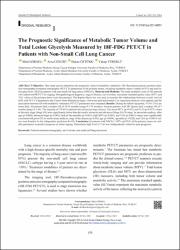| dc.contributor.author | Göksel, Sibel | |
| dc.contributor.author | Cengiz, Arzu | |
| dc.contributor.author | Öztürk, Hakan | |
| dc.contributor.author | Yürekli, Yakup | |
| dc.date.accessioned | 2022-12-09T11:32:09Z | |
| dc.date.available | 2022-12-09T11:32:09Z | |
| dc.date.issued | 2021 | en_US |
| dc.identifier.citation | Goksel, S., Cengiz, A., Öztürk, H. & Yürekl, Y. (2021). The prognostic significance of metabolic tumor volume and total lesion glycolysis measured by 18f-fdg pet/ct in patients with non-small cell lung cancer. Journal of Oncological Science, 7(3), 150-158. http://doi.org/10.37047/jos.2021-86651 | en_US |
| dc.identifier.issn | 2651-4532 | |
| dc.identifier.uri | http://doi.org/10.37047/jos.2021-86651 | |
| dc.identifier.uri | https://hdl.handle.net/11436/7253 | |
| dc.description.abstract | Objective: This study aims to determine the prognostic value of metabolic volumetric 18F-fluorodeoxyglucose positron emission tomography/computed tomography (PET/CT) parameters of the primary tumor, including metabolic tumor volume (MTV) and total lesion glycolysis (TLG) in patients with non-small cell lung cancer (NSCLC). Material and Methods: The study included a total of 102 patients who underwent PET/CT for staging. Histopathological diagnosis, stage of disease, survival time, maximum standard uptake value, MTV, and TLG values of the primary tumor were documented. The Kaplan-Meier test was used to examine the relationships between overall survival (OS) with PET/CT parameters and Tumor-Node-Metastasis stages. Univariate and multivariate Cox regression analyses were applied, and the association between OS with metabolic volumetric PET/CT parameters was estimated. Results: During the follow-up period, 93 (91.17%) patients died. All patients had a median OS of 10.15 months (range 0.5-74 months), whereas patients with M1 disease had a median OS of 7 months (range 0.5-56). The majority of (79.41%) patients had advanced-stage disease. The mean MTV (p=0.012) and TLG (p=0.037) values at the early stage (Stage I-II) were significantly lower than the locally advanced and advanced (Stage III-IV) stage. In univariate analysis, elder age (p=0.004), advanced stage (p<0.001), lack of the operable (p<0.001), high MTV (p<0.001), and TLG (p<0.001) values were significantly correlated with poor OS. In multivariate analysis, stage of the disease (p<0.05), age (p=0.004), operable (p=0.022), and TLG (p=0.0019) values were found to be the independent predictors for OS. Conclusion: In patients with NSCLC, MTV and TLG of the primary tumor are suitable parameters to predict prognosis at initial staging. Particularly high level of TLG was independently related to poor prognosis. | en_US |
| dc.language.iso | eng | en_US |
| dc.publisher | Türkiye Klinikleri | en_US |
| dc.rights | info:eu-repo/semantics/openAccess | en_US |
| dc.subject | Non-small cell lung carcinoma | en_US |
| dc.subject | Positron-emission tomography | en_US |
| dc.subject | Survival rate | en_US |
| dc.title | The prognostic significance of metabolic tumor volume and total lesion glycolysis measured by 18f-fdg pet/ct in patients with non-small cell lung cancer | en_US |
| dc.type | article | en_US |
| dc.contributor.department | RTEÜ, Tıp Fakültesi, Dahili Tıp Bilimleri Bölümü | en_US |
| dc.contributor.institutionauthor | Göksel, Sibel | |
| dc.identifier.doi | 10.37047/jos.2021-86651 | en_US |
| dc.identifier.volume | 7 | en_US |
| dc.identifier.issue | 3 | en_US |
| dc.identifier.startpage | 150 | en_US |
| dc.identifier.endpage | 158 | en_US |
| dc.relation.journal | Journal of Oncological Science | en_US |
| dc.relation.publicationcategory | Makale - Uluslararası Hakemli Dergi - Kurum Öğretim Elemanı | en_US |


















